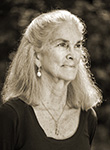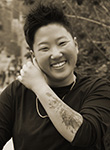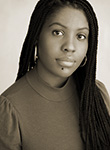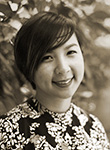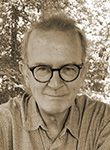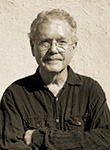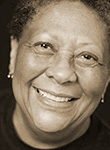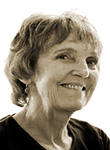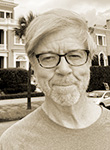Over many years, the work of Margaret Gibson has demanded that we pay attention, that we find and examine our place, and her poems are profoundly engaged with investigating how the natural world and humans—as part of nature—make meaning out of one another. In her poem “Living History” she writes: “And then, like a wolf tree in high wind, / the narrative cracks / open,” and in “Corn Mask,” “I want to respond to this life / with the sanity / that times the arrival of bees / with the breakout of blossoms.”
Her work is emblematic of the mood that appears to motivate many of the writers gathered in this issue, and as she states in a brief correspondence published in Features: “The practice of paying attention is more focused than that of simply noticing. I can easily notice something and be instantly distracted. When noticing becomes paying attention, and when you practice paying attention moment by moment, a deepening awareness develops.”
As we are buffeted by the chaos that has come to be our daily ration, we thank these writers who have generously shared their work and who thus help us feel less alone in this time and this life. They brilliantly pay attention.
A review by poet Tim Seibles of Gibson’s recent collection of poems, The Glass Globe, appears in Nonfiction.
Each spring, Blackbird’s Introductions Reading Loop recognizes new artists of note whose work strikes us as exceptionally fine and full of promise. Joining this company for 2022 are poets Caleb Braun, Colby Cotton, Simon Shieh, and Arhm Choi Wild, fiction writers Lena Fultz and Patricia García Luján, and nonfiction writer Catharina Coenen.
In three poems by Caleb Braun, idyllic reflections weave between past and present and invite his readers to walk with him on his journey. The meditative venture into memory, the names “from an unfinished childhood,” are reminders in themselves of how memories resist time and change as “we try to keep what makes us.”
“What I want is for someone to watch over him as he walks his youngest to her grave,” Catharina Coenen tells us of the life of her grandfather. In “Ulcerations,” a piece of speculative nonfiction, she chronicles his navigation of the loss of his child in post-World War II Germany. Through photographs, family stories, and medical similarities, Coenen attempts to forge a connection between herself and her grandfather, and identify the ways in which, despite temporal distance, this family history is a part of her.
Poems like “Existence” highlight Colby Cotton’s concerns with ontology, language, life, and the persistence of meaning. “Last night my neighbor blew on a spoon, and disappeared,” he tells us as the poem’s speaker confronts the transitory nature of marks left in life. In “The New Poem,” Cotton places existential concerns in relation to place: “inexact in what I mean // when I say, I was lonely then, as I am now / standing in the foyers of paintings of landscapes, / abstract impressionism, Gothic architecture.”
“I am telling you a lot of things and it is only to tell you this: Lucas is my brother and once Nana and Pawpaw die, I am going to be the only person who knows how to look out for him,” Lena Fultz declares in “Signals.” Her story focuses on a small child who is the caretaker for her older brother, and the constant threat of their ailing grandparents’ death, and subsequent separation of the brother and sister, surrounds them at all times—ready to swallow them like the marsh on which they live.
Patricia García Luján’s story tracks Andrea, who, in financial need, agrees to illegally surrogate a child for a couple in Madrid, Spain. Luján highlights the socioeconomic divide between Andrea and those around her, noting: “I want to remind them that although they might be rich, I’m the one with something invaluable.” While other characters flourish, Andrea struggles with self-worth and isolation in a foreign country.
“To think I have finally found myself / beneath all this skin,” Simon Shieh writes in his poem “Self-Portrait,” which investigates a question that permeates much of his poetry: “What makes a man?” His work sifts through the social narratives of masculinity and an overwhelming need to confront them, “As he sleeps, I search his face / for resemblance, / but it is as I feared—ripples only, / the occasional wave.”
In a group of five poems, Arhm Choi Wild explores facets of identity: youth and maturity; femininity and masculinity; defiance and fatigue. Their work gives the reader insight into “a way to kiss a shard and, maybe, swallow it to see what your body can survive.” Wild’s words are a perspective into the wider culture’s daily demand that they justify their existence within it. “The worker will say, what // can I help you with sir, and then stumble and apologize as if / they just decanted my favorite whiskey all over my new oxfords.”
Short statements by Braun, Coenen, Cotton, Fultz, Luján, and Shieh appear in the Feature Tracking the Muse.
The seventh annual Claudia Emerson Reading Loop Loop features Emerson’s poems “Photographer” and “Triptych.” “Photographer” was the subject of an interview with poet Brian Brodeur for his blog How a Poem Happens, which is republished here with his permission. Accompanying these texts is a selection of photographs of Emerson’s Richmond study taken by Lauren Miner after her death.
Our annual presentation of materials related to the VCU Cabell First Novelist Award includes an excerpt from 2021 winner Raven Leilani’s novel Luster (Farrar, Straus and Giroux, 2020), alongside a transcript of a Q&A conducted during her visit to VCU. This novel follows Edie, a twenty-three-year-old Black woman, who experiences “the potent drug of a keen power imbalance” when she has an affair with a middle-aged white man—and then becomes entangled with his family. A review of the novel by Ty Phelps appears in Nonfiction.
“The dust of homes is mostly skin. Face falls from face,” Bruce Bond writes in his poem, “Blackbird,” an ambitious contemplation of the various facets of selfhood and the way identities are developed as “inflections of the whole.” With a nod to Wallace Stevens, the blackbird is continually reframed, like thought: “In memory / of an evening too light to bear, the wings of ash, crossing over.” His poem “Sea,” too, investigates naming and self-making, “The blue some call / borrowed, others Earth.”
In the poem “Zombie Apocalypse Now: Survival” Cathy Linh Che creates all-too-real images of enduring a wartime life through a lens familiar to a western audience: a science fiction film. Prismatic in approach, the self-referential use of a camera to frame meaning rhetorically refracts meaning so that what is and is not reality becomes blurred for an imaginary viewer: “So much napalm / faked: it looked // just like / the real thing.”
Three poems by Adam Chiles serve as lyric elegies to his late father and manifest as acts of memory and love. In “Fauré” the poet watches his father at breakfast, “Which is to say, an ordinary morning / in the middle of their lives, where I was a child, / and the house an isle of incalculable light.”
Kathy Fagan’s poems inspect the complexities and persistence of child/parent relationships in the face of their inevitable end and reverberating effects on the speaker’s life. Through vulnerability and introspection, Fagan attempts to reconcile the speaker’s own identity in relation to her mother. In her poem, “Trace,” the speaker asks, “How could both continue to exist?”
In “Hillwood,” Mark Jarman writes: “When it was gone, / we missed it but soon stopped missing or giving it / shape.” The poems here engage individual formulations and perceptions of existence, and the inevitable residue of those existences after loss. Jarman’s poems are also concerned with the way image—concrete and figurative—makes or reveals meaning; in “Sick Fox,” he writes: “The news is not good. / It must have been that, that I was looking at. / And grief. I was looking at grief.”
Rodney Jones’s poems, “Effacement” and “When Everything Is Nothing,” explore the organic and unspoken aspects of creating literary art and reel us back to ponder the conception of artistic creativity itself, breathing fresh air into what it indeed means to be an artist. Along the way, Jones offers us all an encounter with sensational enlightenment.
“Antidiluvian,” “Covenant,” “Diluvian,” and “Postdiluvian” by Emilia Phillips explore themes of morality and death in a reimagining of Noah’s ark. Here, the speaker is an onlooker to the sacred scene, witnessing the despair first-hand. She plays a role of a woman, part of the “captive stock,” ultimately submissive “to the world . . . to God and to [her] husband.” A moment held as the pinnacle of salvation reconstitutes, in this retelling, to be full of death, flesh, and rape.
In Fiction, Bruce Kilstein’s “The Recipe for Making Blood,” presents a doctor’s dilemma of fulfilling professional obligations while also respecting a patient’s personal, religious restrictions. One of Dr. Eliot Sanders’s patients, Henrietta Mobley, desperately needs a blood transfusion. However, Eliot finds himself stymied by Henrietta’s religious adherence, and both are caught in a moral in-between space: “In the meantime, she would lie suspended between life and death. Eliot was stuck in a situation where he had a treatment that he was forbidden to use.”
Marilyn Nelson continues her translation from the Danish of Inge Pedersen’s novel The Path Leads through the Air, in its seventh installment, “I Said Nothing.” Here, the narrator works to emotionally recover from the disintegration of her relationship with her boyfriend. Despite her attempts at avoidance, she is reminded of her failed relationship through repeated and unwanted letters from her ex.
The eighth installment from Wesley Gibson’s You Are Here: A Memoir of Arrival appears in Nonfiction. Through Gibson’s signature cynicism and brutal honesty, we see his relationships with friends and students wax and wane as he struggles to settle into New York City and continues to doubt his sexuality, exclaiming he “couldn’t get anything right, not even being gay.” Gibson struggles with his anxiety, describing an evocative and near-horrifying anxiety attack, saying: “they crumple you up and rim-shot you into the trash can.”
Also in Nonfiction, Philip Arnold’s “Alfred and the Axis Mundi” creates a scenic world of companionship and trust, engaging readers in the often larger-than-life figure of Alfred, a neighbor of Arnold’s, while anchored in the green fields and red barn settled in a hollow in North Carolina. Arnold, through Alfred, demands: “Now, what you need to do is turn your fingertips into big old eyeballs. It might help to tune out everything. Shut your mind down. Just feel it.”
Danielle Kotrla reviews Matthew Wimberley’s Daniel Boone’s Window, and Blackbird editors present short reviews of recent books to complete the section.
In Gallery, Kevin Concannon’s “Actionable Art: From Sam’s Café to United Art Contractors” recounts the Sam’s Café scandal of 1971, a conceptual art project involving “direct mailed pieces and advertisements” in the form of fake bills and human excrement that resulted in a district court trial. In this compelling compilation of photographs, article excerpts, and transcripts, Concannon explores the seemingly limitless potential of artistic form and forces us to question the line between censorship and perspective, trash and treasure.
In Features, in addition to Reading Loops for the Introductions, Claudia Emerson, Margaret Gibson, and the Cabell First Novelist Award, Blackbird associate editors present short email correspondences with Katarzyna Jakubiak, winner of the 2022 Rebecca Mitchell Tarumoto Short Fiction Prize, Gwen E. Kirby, and Margaret Gibson to round out the issue. ![]()
Return to top menus | Browse issue
